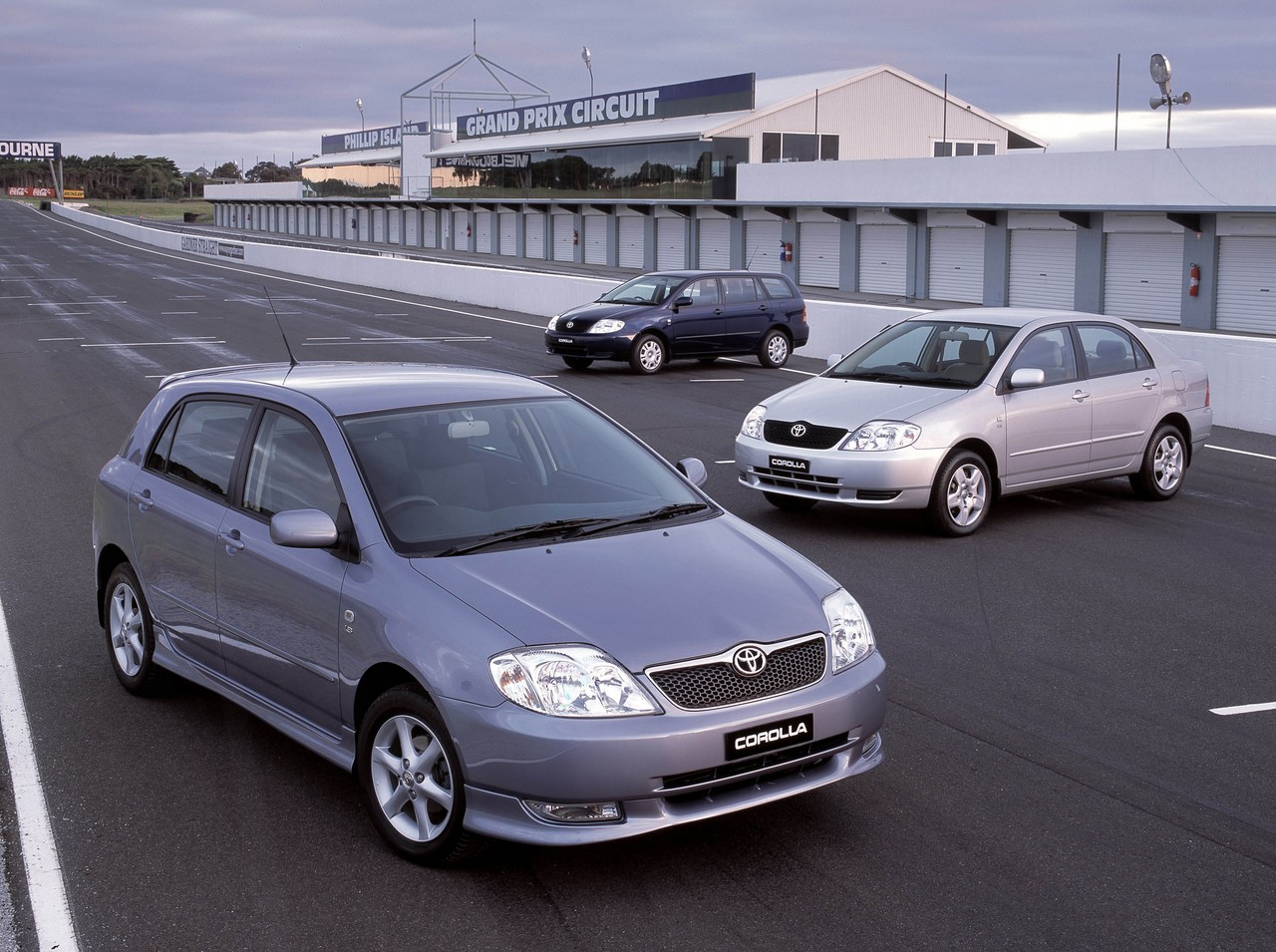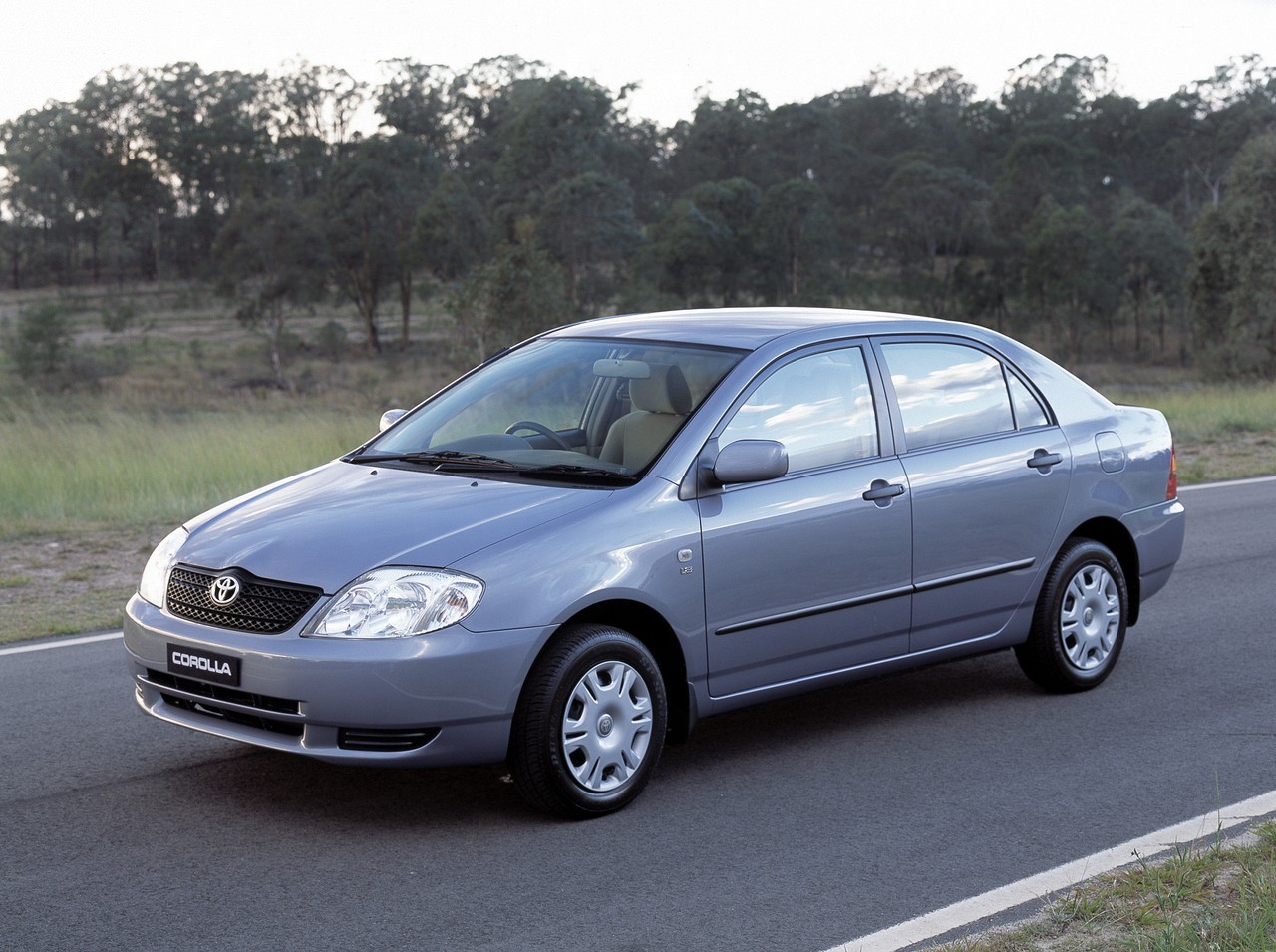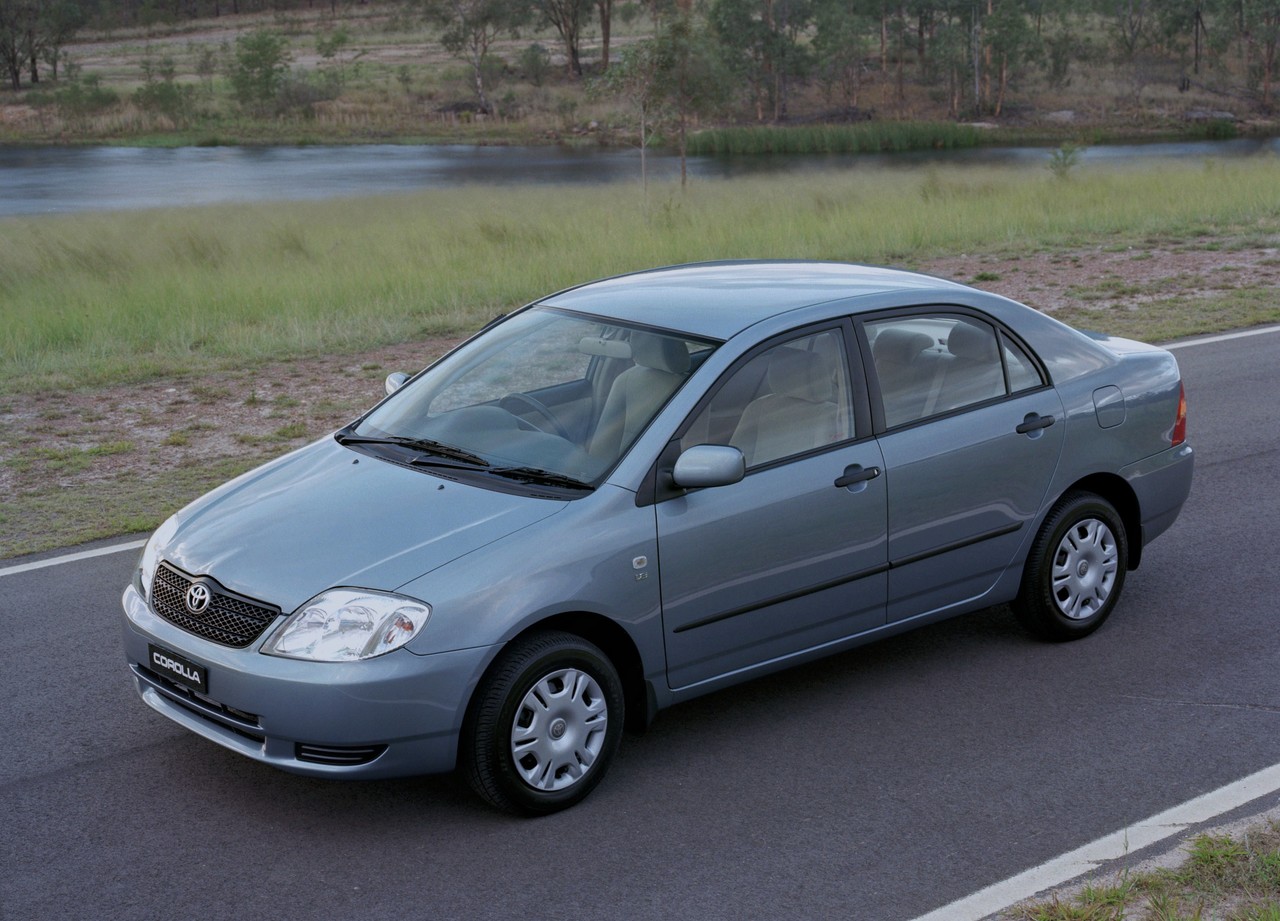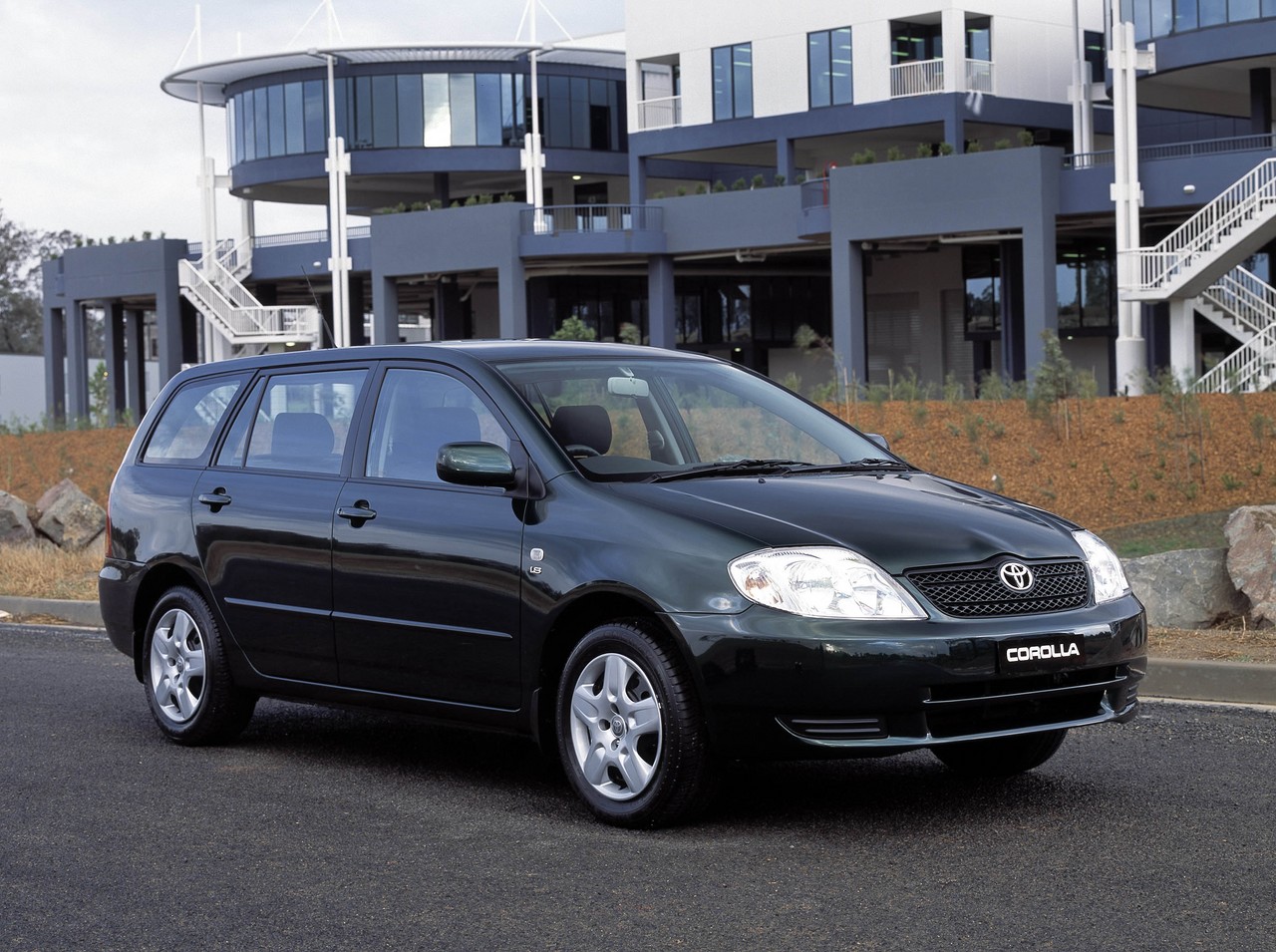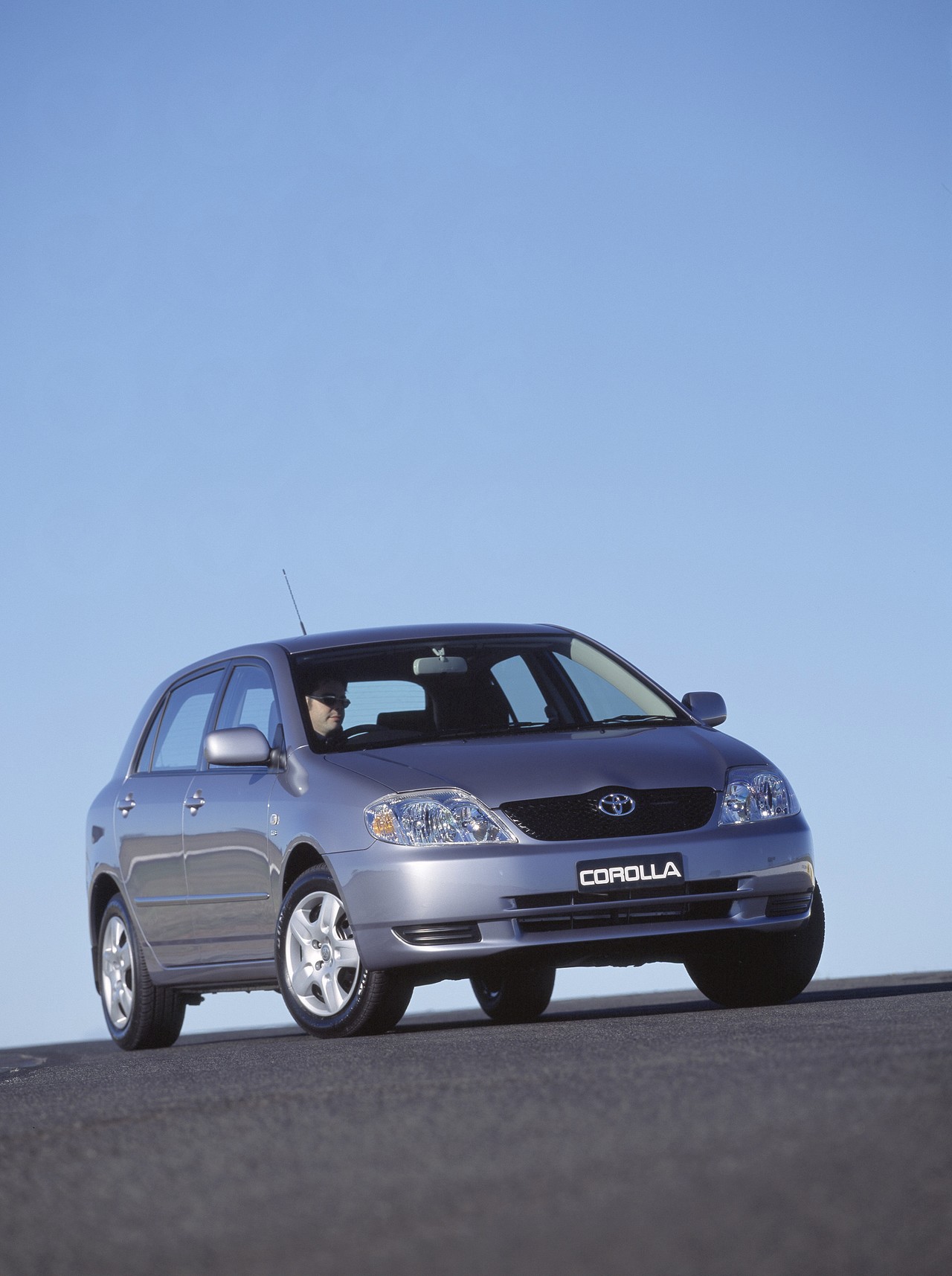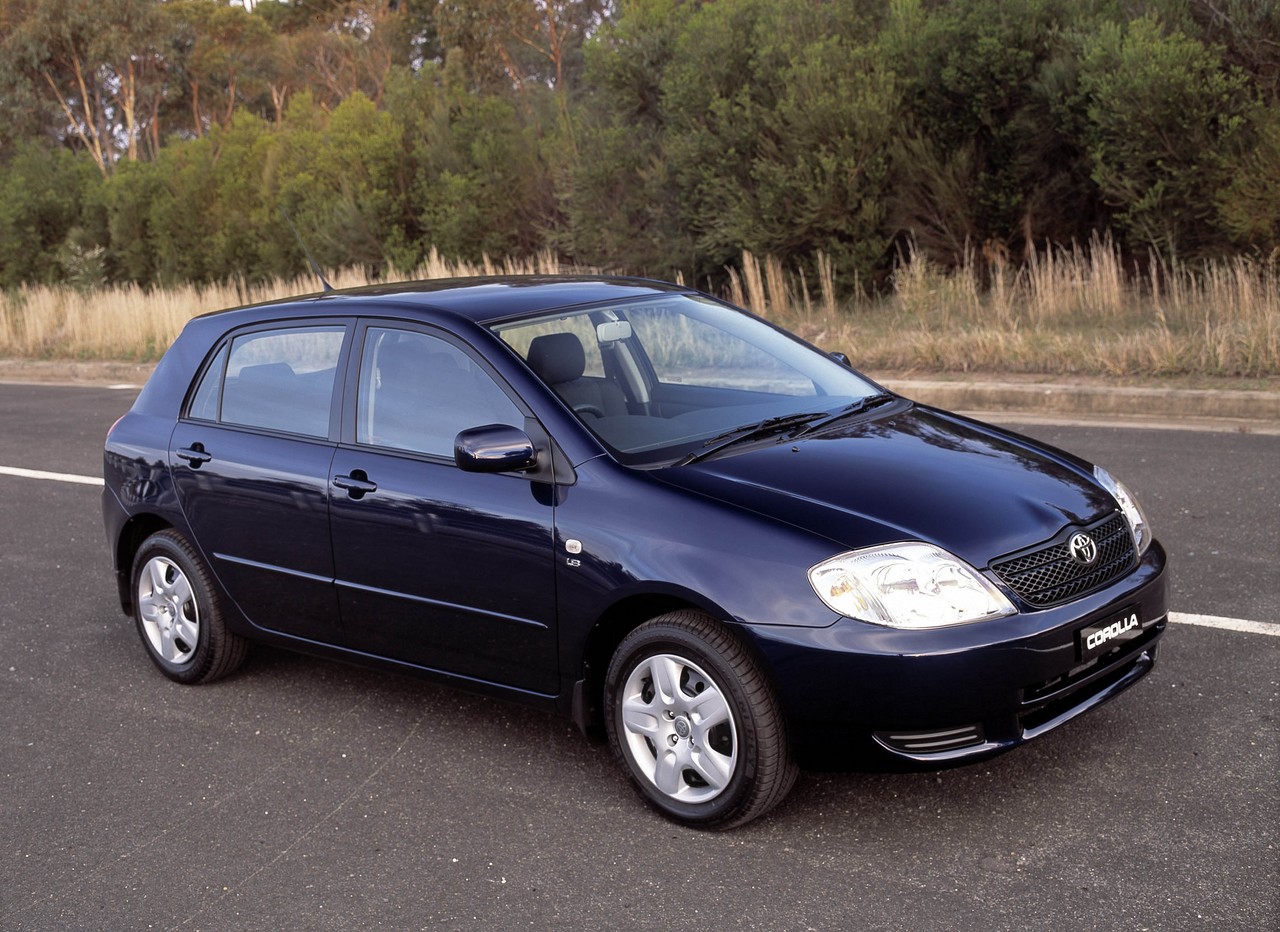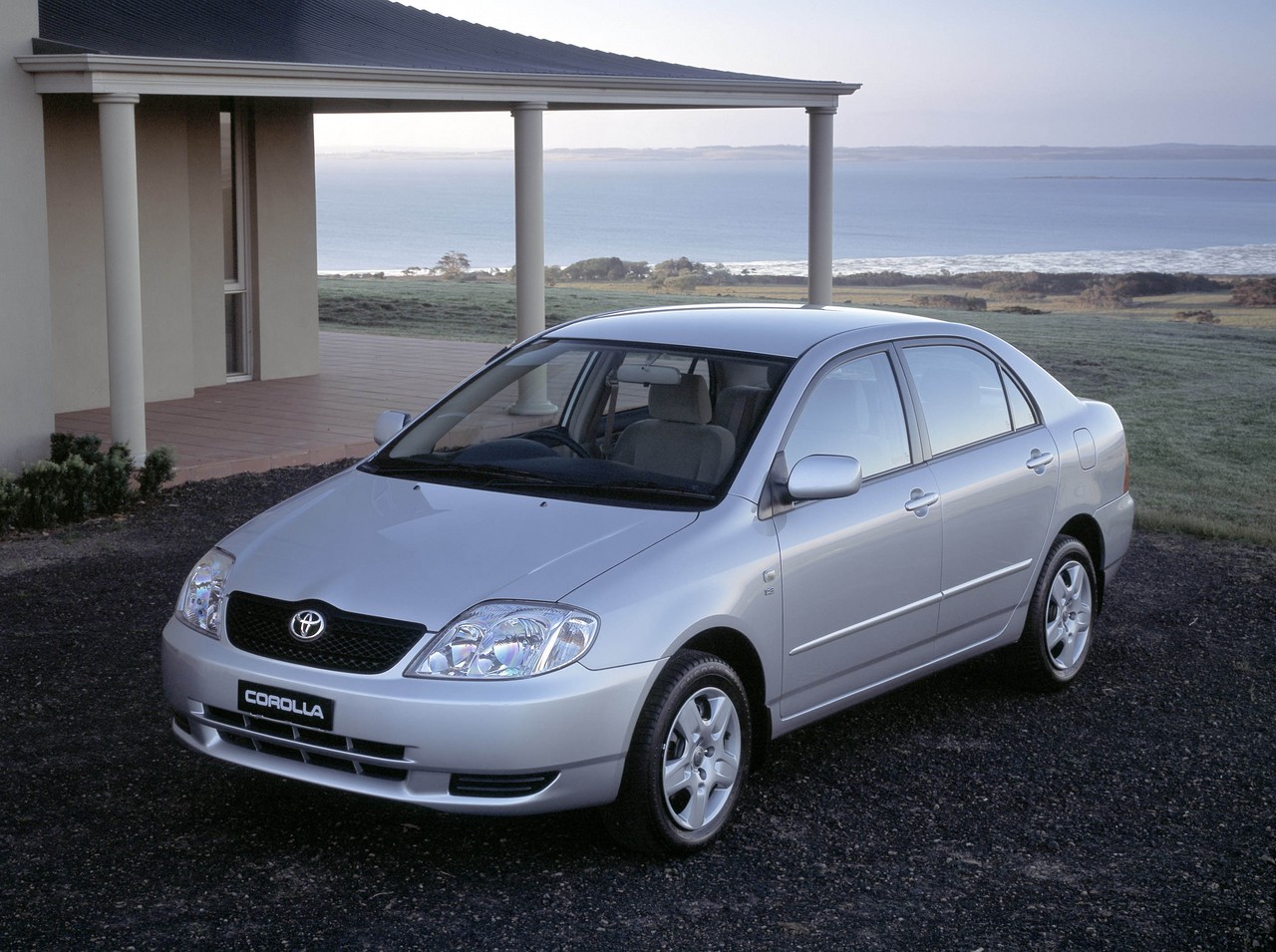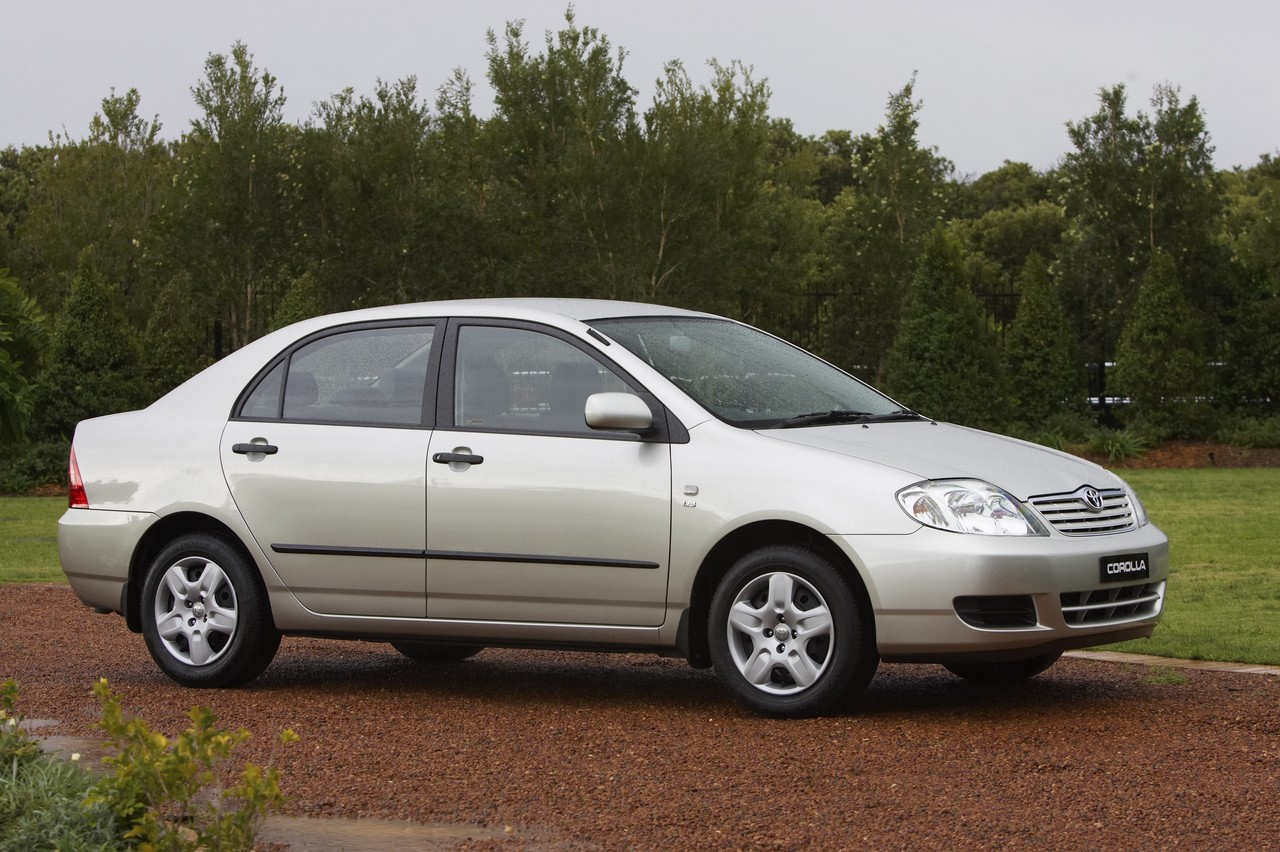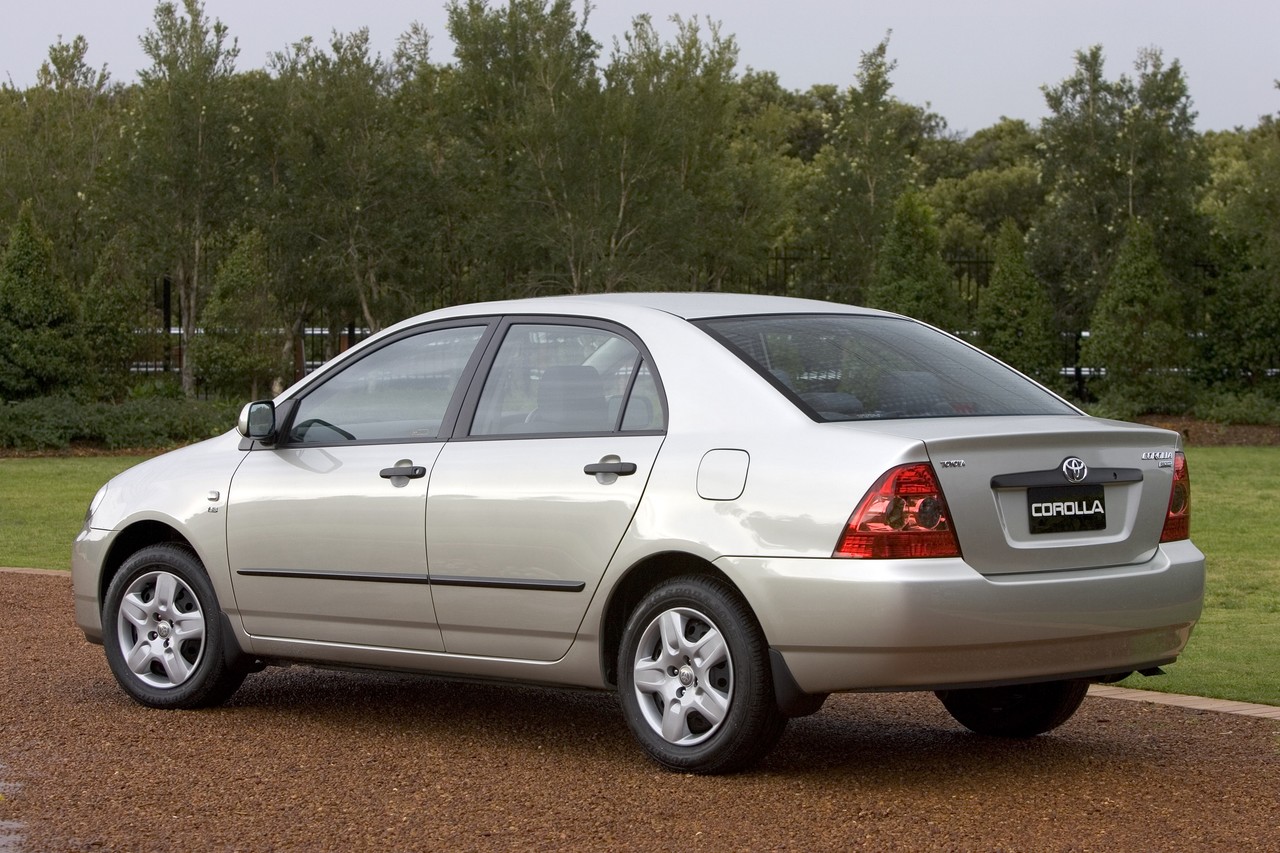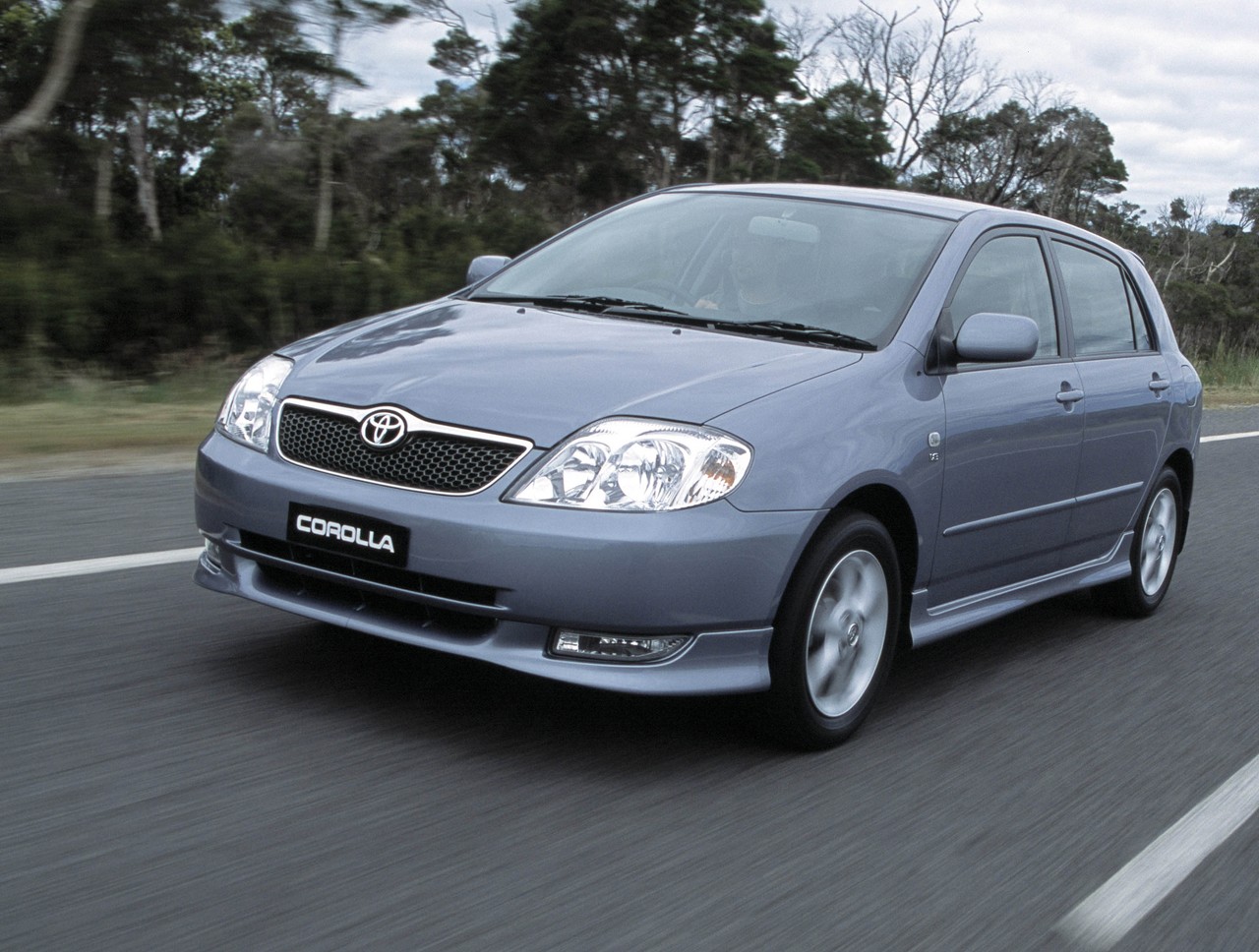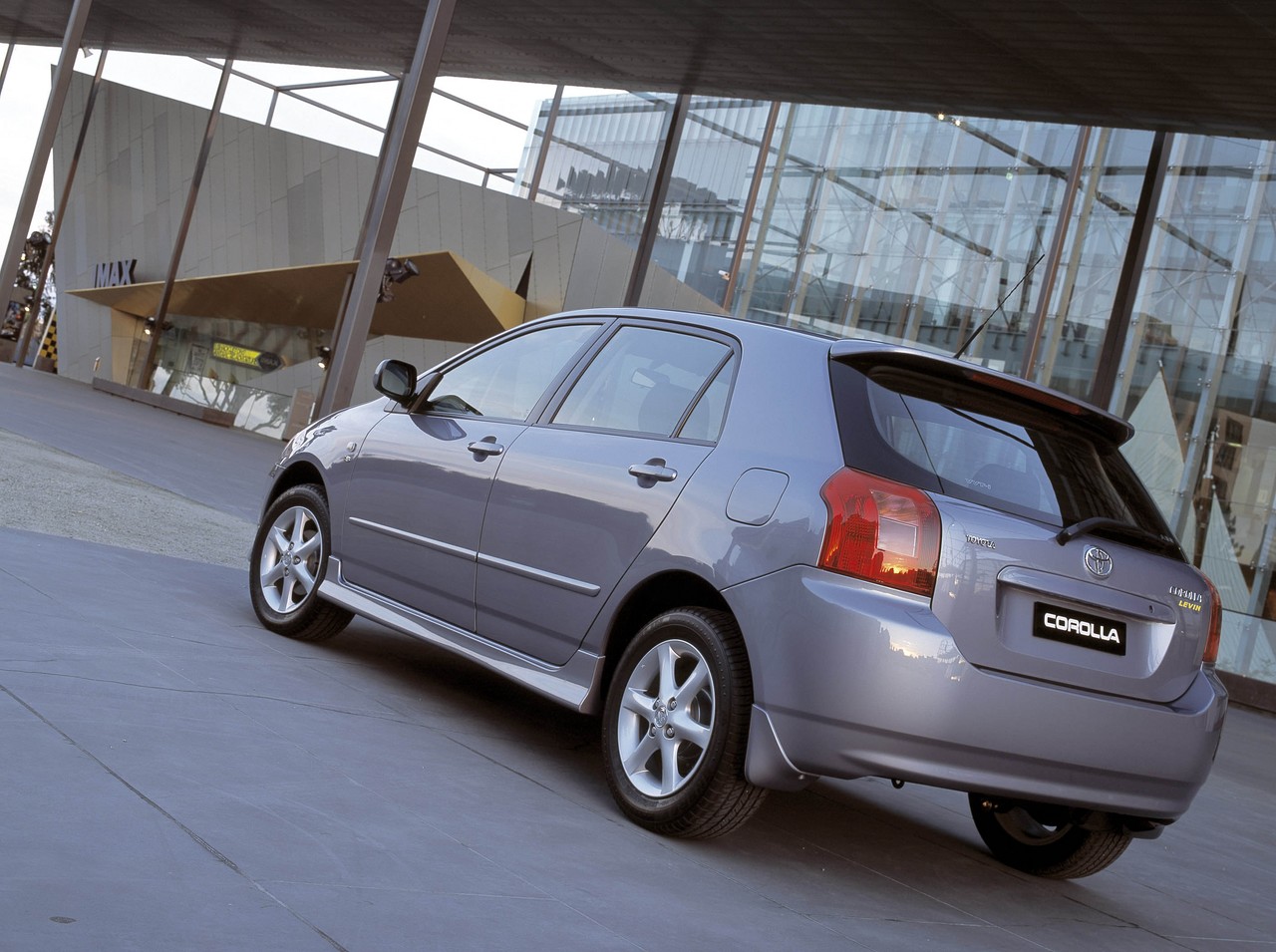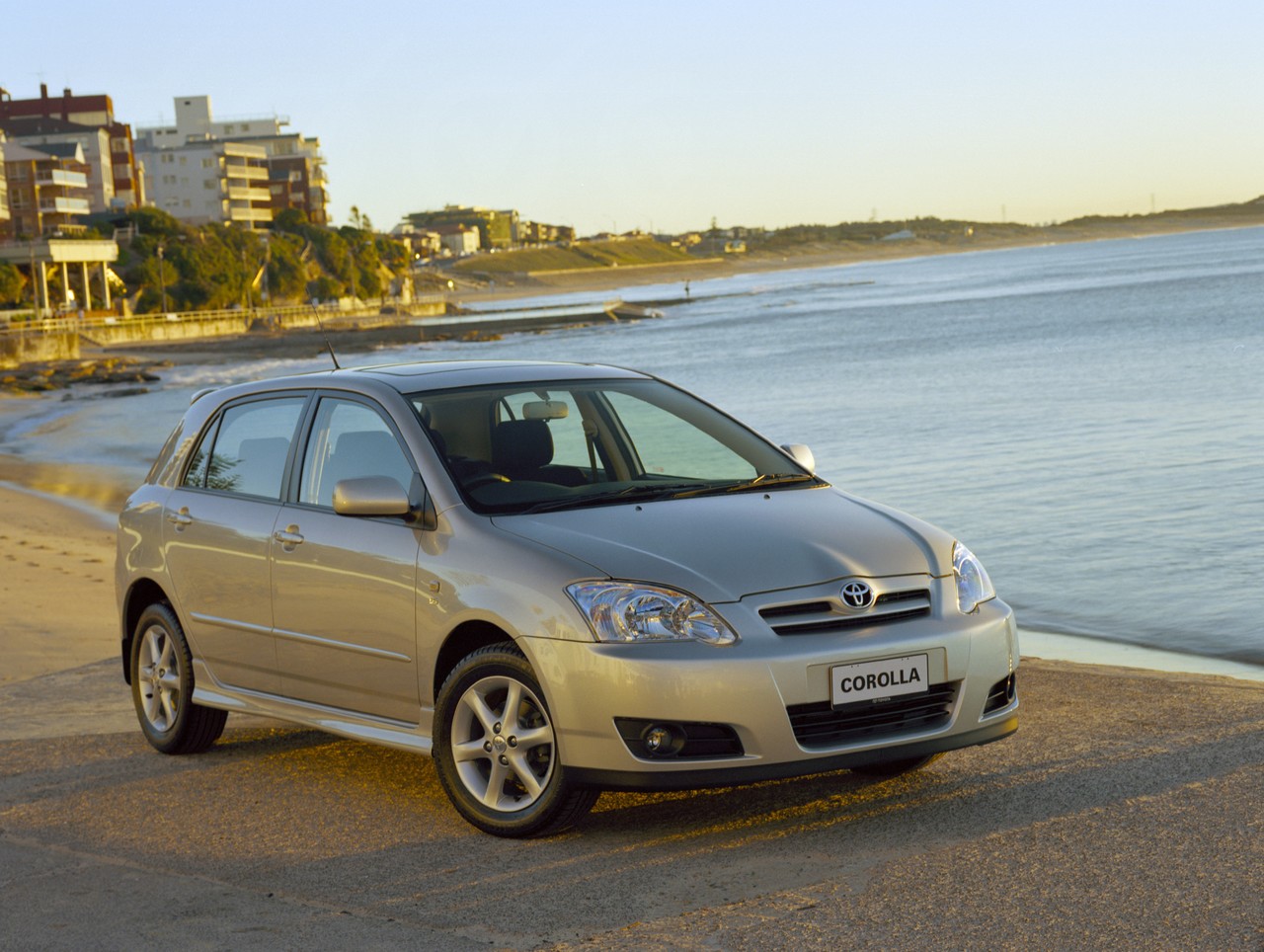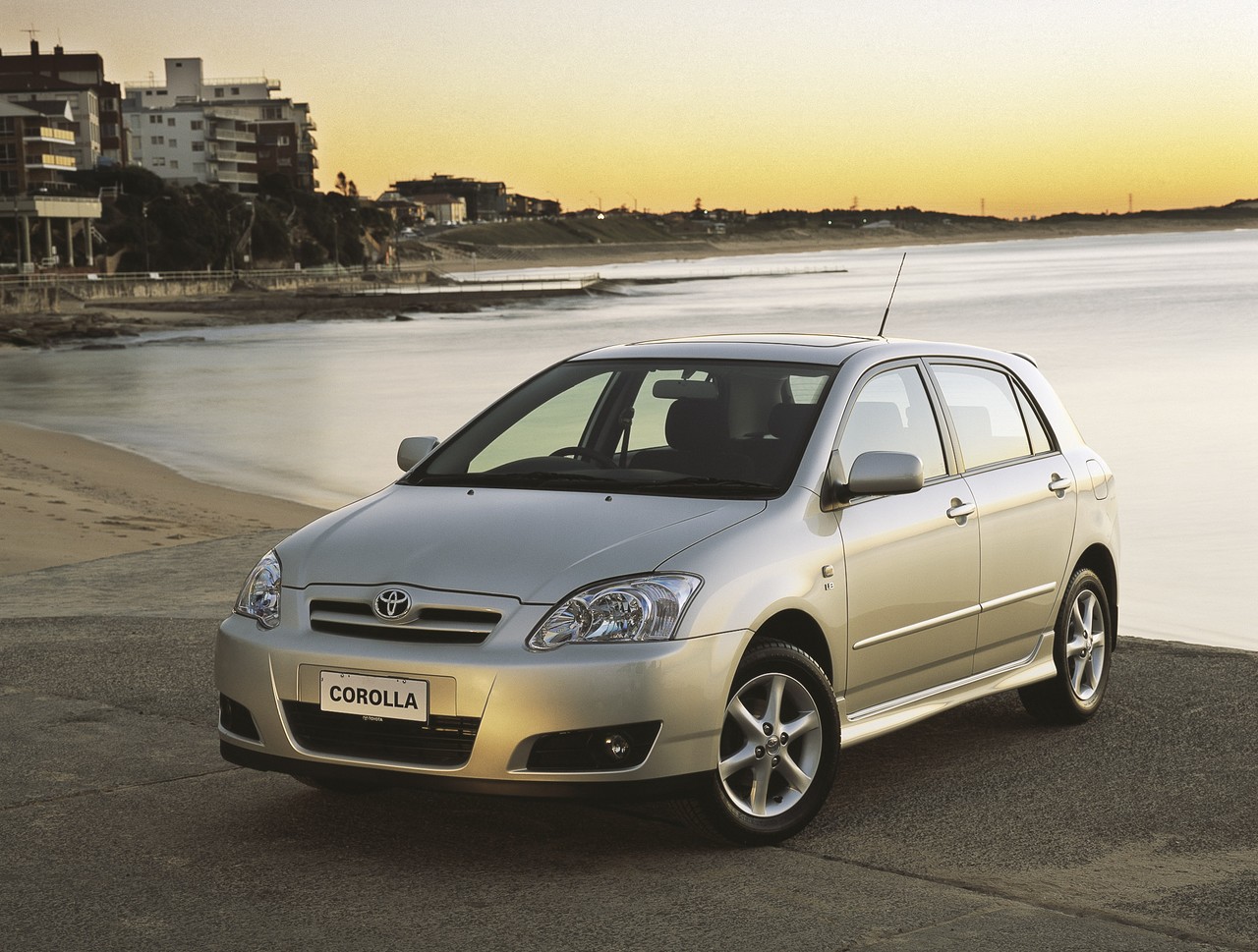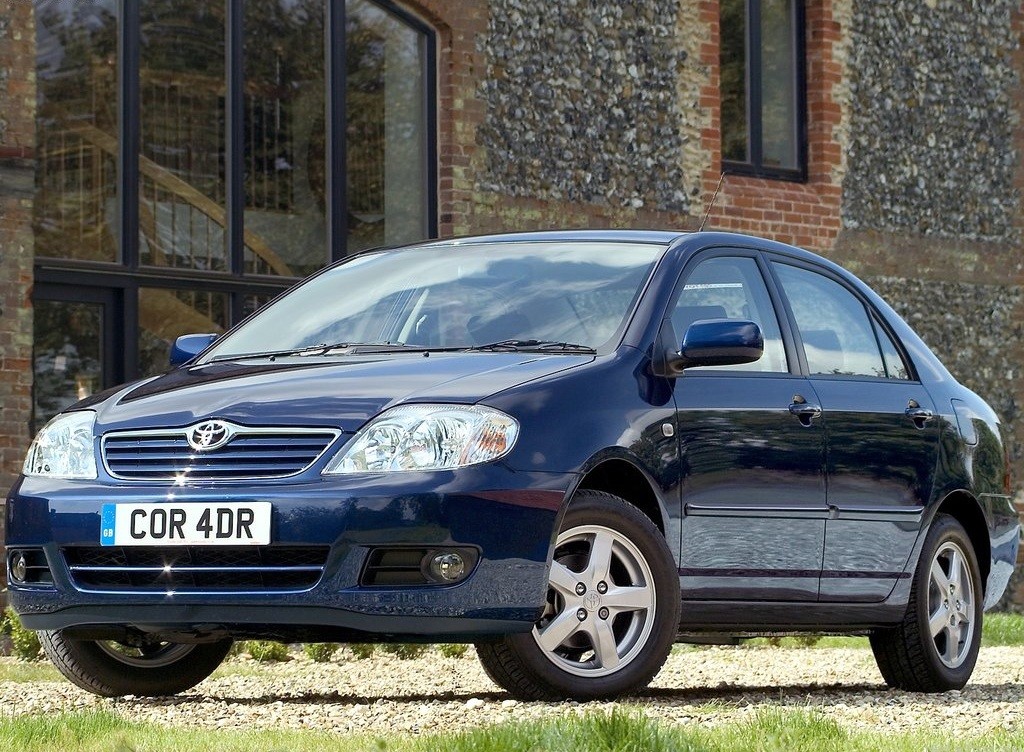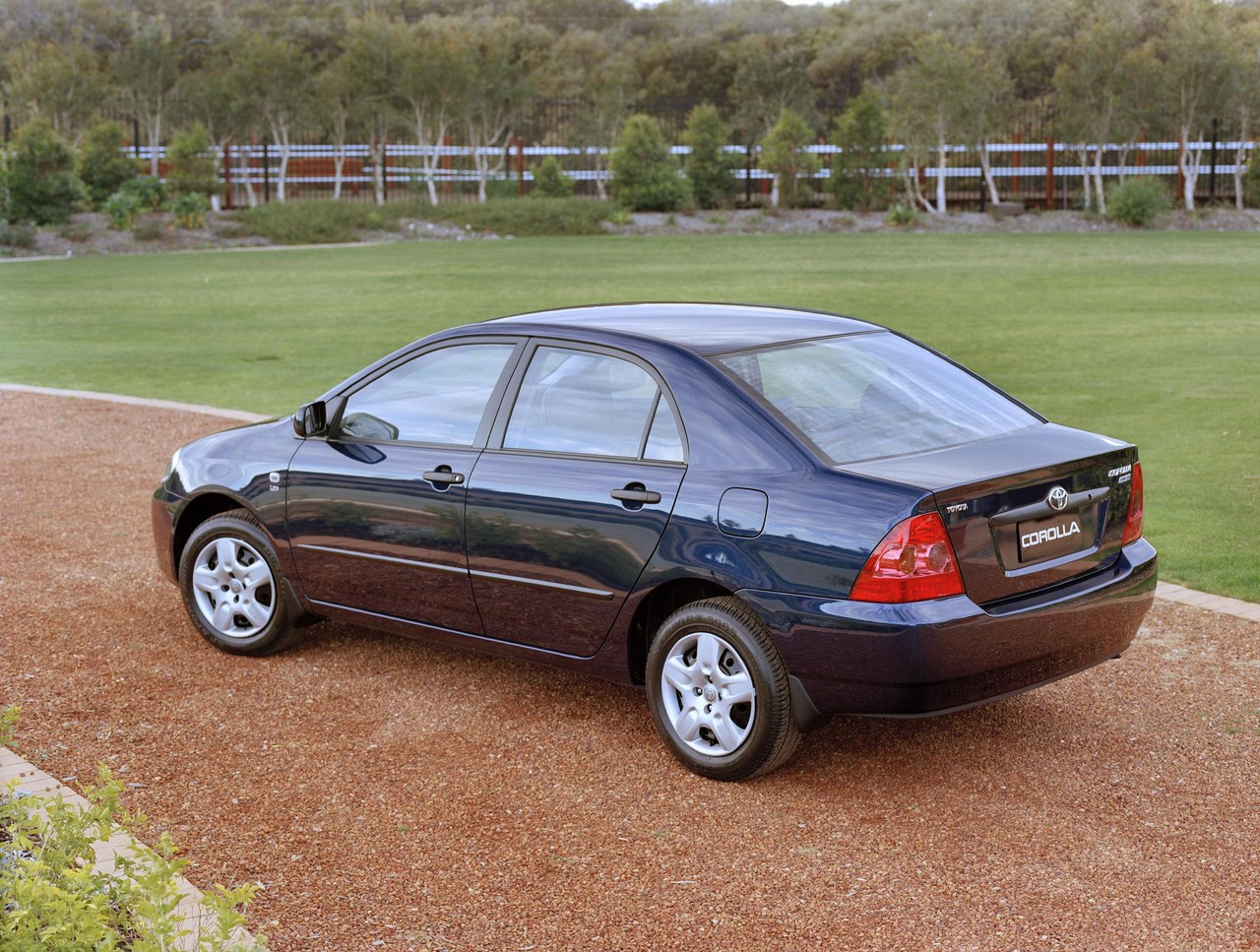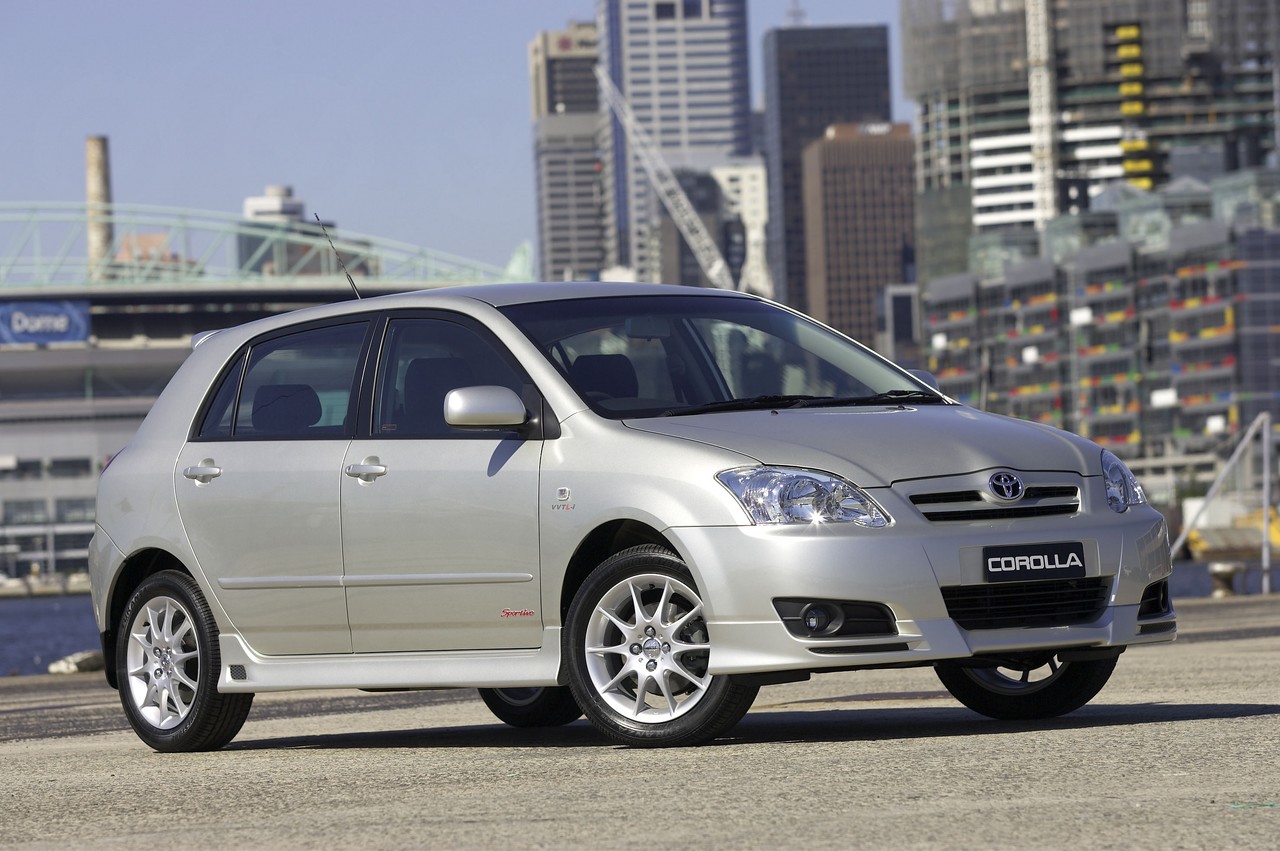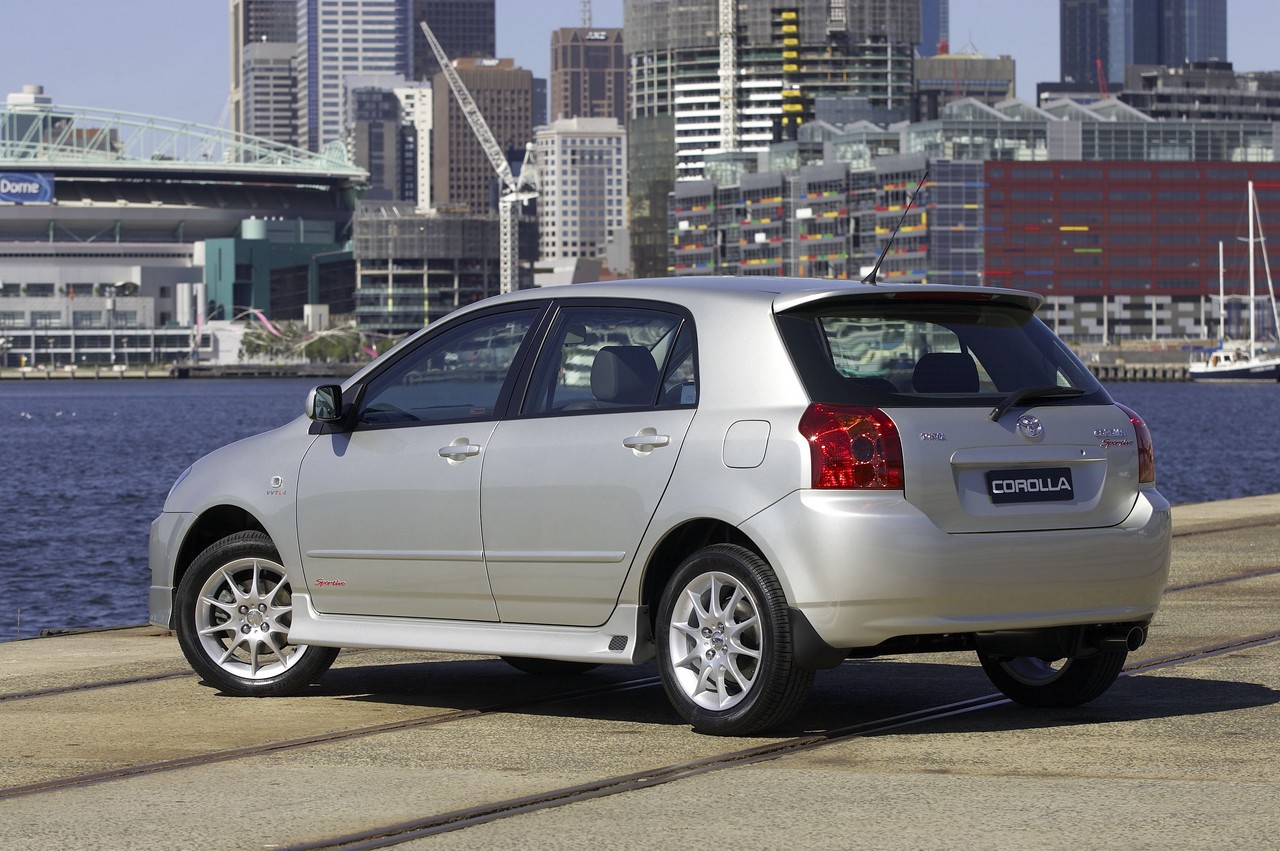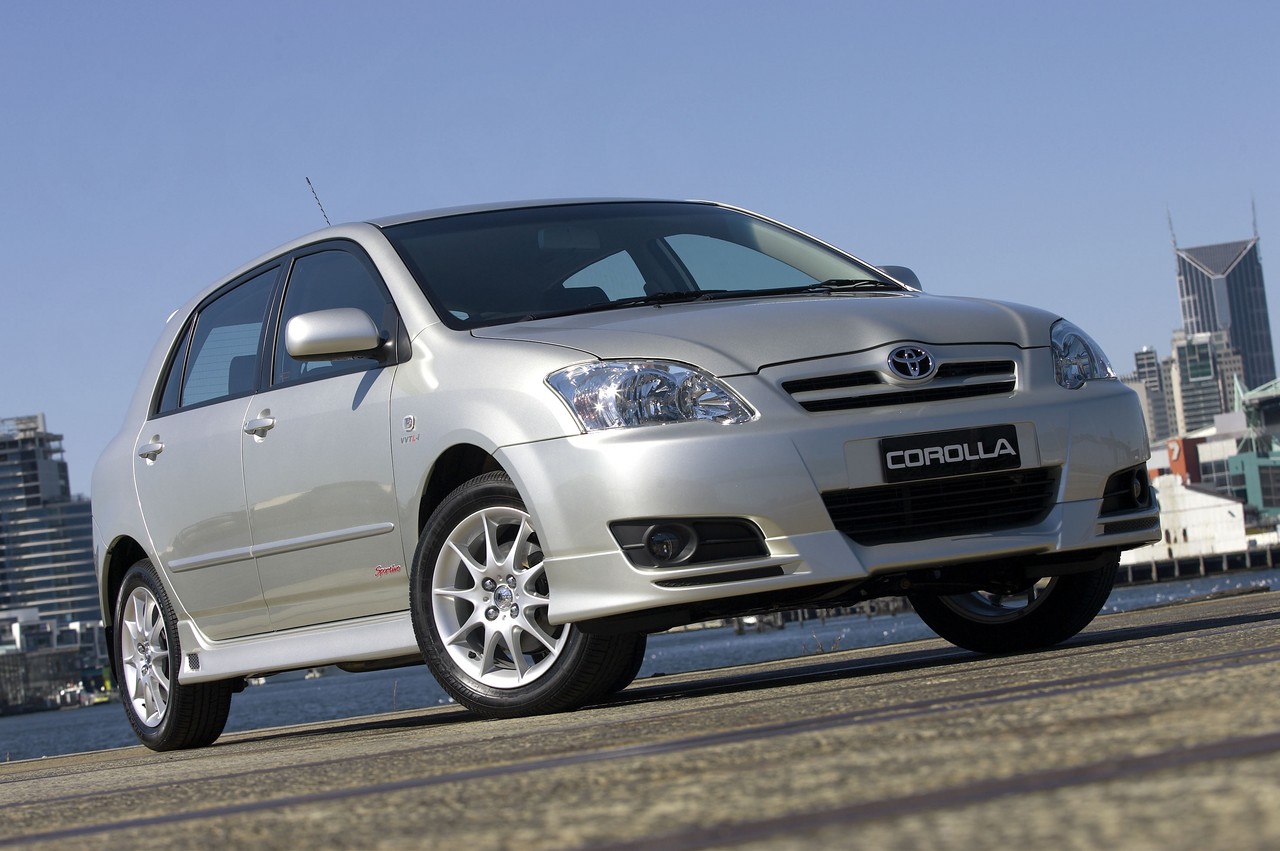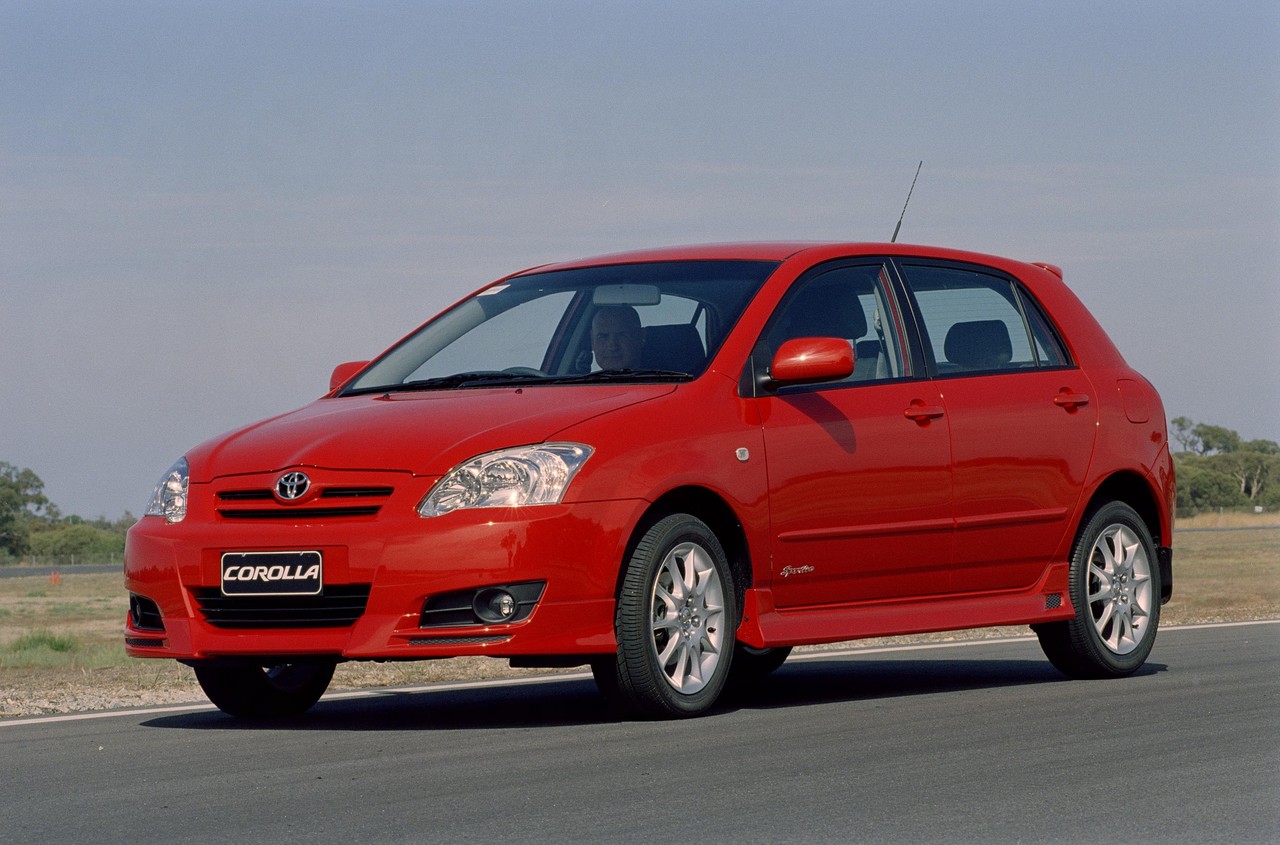
- With the manual transmission, the 1.8-litre 1ZZ-FE engine provides responsive performance
- Comfortable front seats
- High standard of fit and finish
- Well-weighted steering
- Generally comfortable ride…
- … though suspension lacks low-speed compliance on 15-inch wheels
- Automatic transmission too eager to downshift on throttle inputs
- Underwhelming dynamics
- Steering wheel kickback over bumps
- Short gearing for manual transmissions, e.g. 3500 rpm at 110 km/h (increasing engine noise and fuel consumption)
- For Corolla Sportivo, engine noise at higher rpm and notchy gearshiftslt
Review: Toyota E120.I Corolla (2001-04)
Overview
Released in December 2001, the Toyota E120 Series I (E120.I) Corolla was available as a five-door hatchback (‘Seca’), wagon or sedan. Initially manufactured in Japan, the front-wheel drive Corolla was powered by a 1.8-litre four-cylinder petrol engine that was mated to either a four-speed automatic or five-speed manual transmission. The Corolla range initially consisted of four variants: the entry-level Ascent, mid-range Conquest, sports-themed Levin and range-topping Ultima.
In May 2003, the range was expanded with the introduction of the South African-built Sportivo variant, which was powered by Toyota’s 2ZZ-GE engine and had a six-speed manual transmission. Standard features were also extended for the rest of the Corolla range, with a minority – perhaps a quarter – of these models manufactured in South Africa (see ‘South African or Japanese build?’, below).
1ZZ-FE and 2ZZ-GE engines
Of the engines,
- For the standard Corolla variants, the 1.8-litre 1ZZ-FE engine had an aluminium block and cylinder head, sequential electronic fuel injection (EFI), double overhead camshafts (chain-driven), four valves per cylinder, variable intake valve timing (Toyota’s ‘VVT-i’) and a compression ratio of 10.0:1; and,
- For the Corolla Sportivo, the 2ZZ-GE engine differed in that it had forged steel connecting rods, iron pistons with tin-coating, variable intake valve timing and lift (‘VVTL-i’), flat-topped pistons with valve clearance cut outs, a 4-2-1 extractor-type exhaust system and a compression ratio of 11.5:1.
While the 1ZZ-FE engine was available with five-speed C52 manual and four-speed A245E automatic transmissions, the Corolla Sportivo’s 2ZZ-GE engine was mated to a six-speed close-ratio C64 manual transmission.
Body and dimensions
Sharing its platform with the T230 Celica , the E120 Corolla introduced a ‘cab forward’ design which was 37 kilograms lighter on average – on a model for model basis – than its E110 Corolla predecessor.
Compared to the E110 Corolla , the E120 hatchback was 120 mm shorter (at 4175 mm), yet 5 mm wider (1695 mm), 85 mm taller (1470 mm) and had a 135 mm longer wheelbase (2600 mm). Compared to the hatchback, the E120 sedan and wagon were 190 mm and 210 mm longer, respectively (at 4365 mm and 4385 mm); the wagon also had a 5 mm higher roofline (1475 mm).
Suspension
The E120 Corolla had MacPherson strut front suspension with L-shaped lower arms, gas-pressurised double-acting hydraulic dampers and a ball-joint mounted stabiliser bar. The rear suspension utilised a semi-independent trailing torsion beam with coil springs, gas-pressurised double-acting hydraulic dampers and a stabiliser bar.
| Body | Variant | Engine | Trans. | Peak power | Peak torque |
|---|---|---|---|---|---|
| Hatchback (5dr, ‘Seca’) | Ascent, Conquest, Levin |
1.8-litre petrol I4 (1ZZ-FE) | 4sp auto, 5sp man. |
100 kW at 6000 rpm | 171 Nm at 4200 rpm |
| Ultima | 1.8-litre petrol I4 (1ZZ-FE) | 4sp auto | |||
| Sportivo | 1.8-litre petrol I4 (2ZZ-GE) | 6sp man. | 141 kW at 7800 rpm | 180 Nm at 6800 rpm | |
| Sedan | Ascent, Conquest |
1.8-litre petrol I4 (1ZZ-FE) | 4sp auto, 5sp man. |
100 kW at 6000 rpm | 171 Nm at 4200 rpm |
| Ultima | 1.8-litre petrol I4 (1ZZ-FE) | 4sp auto | |||
| Wagon | Ascent, Conquest, Levin |
1.8-litre petrol I4 (1ZZ-FE) | 4sp auto, 5sp man. |
100 kW at 6000 rpm | 171 Nm at 4200 rpm |
Safety equipment
Standard safety features for the Corolla Ascent included a driver’s airbag, front seatbelt pretensioners and a driver’s seatbelt load limiter. The Levin, Ultima and Sportivo were further equipped with a front passenger airbag, ABS, electronic brake force distribution, brake assist and front passenger seatbelt force limiter, while the Levin hatchback and Ultima were also fitted with front side airbags. From May 2003, the Conquest was also fitted with a front passenger airbag.
Brakes
The standard E120 Corolla had 255 mm by 25 mm vented front disc brakes with single-piston floating calipers and 269 mm by 8 mm solid rear discs with single-piston floating calipers.
The Corolla Sportivo, however, had 275 mm by 25 mm vented front disc brakes and 279 mm by 9 mm solid rear discs.
ANCAP and Euro NCAP crash testing
In ANCAP crash testing , a 2001 E120 Corolla hatchback – equipped with a single driver’s airbag – received a four star adult occupant protection rating with a score of 27.33. In the frontal offset impact test, the airbag cushioned the driver’s head and protection from serious injury was good, but the driver’s came partially out of the side window during rebound and struck the b-pillar; the ignition barrel and steering column adjuster bracket also posed a hazard to the driver’s knees. In the side impact test, the Corolla received maximum points.
In Euro NCAP crash testing , a 2002 Corolla hatchback fitted with a 1.4-litre petrol engine and equipped with dual front airbags received a four star adult occupant protection rating with a score of 28. Results from this test were broadly similar with the ANCAP testing.
Features: Corolla Ascent, Conquest, Levin and Ultima
Standard for the entry-level Corolla Ascent included 14-inch steel wheels with 175/70 HR tyres, a four speaker sound system with radio and cassette player, 60/40 split and folding rear seats, central locking, power mirrors, a height adjustable driver’s seat, tilt adjustable steering wheel and an immobiliser. From October 2002, a CD player and remote central locking were fitted as standard.
The Corolla Conquest variants and Levin wagons were further equipped with 15-inch steel wheels (alloys for the Levin) with 195/60 VR15 tyres, a CD player, air conditioning, remote central locking and power front windows. Beyond this, Corolla Levin hatchbacks added a six speaker sound system, front fog lamps and rear powered windows.
The range-topping Corolla Ultima was distinguished by its six-disc CD player, velour upholstery and woodgrain interior trim.
May 2003 changes
From May 2003, the Ascent was fitted with 15-inch steel wheels (previously 14-inch) and sports front seats with driver and passenger seatback pockets. The Conquest was further equipped with 15-inch alloy wheels, sports seats and rear powered windows. Furthermore, all variants were fitted with new seat trim.
Features: Corolla Sportivo
Released in May 2003, key features for the Sportivo included 16-inch ten-spoke alloy wheels with Bridgestone Turanza tyres, a six speaker sound system with six-stack CD player, climate control air conditioning, contoured leather seats, front fog lights, a leather-wrapped steering wheel and gearshift knob, ‘Optitron’ instrumentation, remote central locking and sports body kit.
Toyota Team Racing editions
In March 2004, ‘TTR’ (Toyota Team Racing) editions of the Ascent hatchback and sedan were released. Compared to the standard Ascent, the TTR edition added alloy wheels, a rear spoiler, TTR emblem and body-coloured door handles and side protection mouldings.
Corolla: South African or Japanese build?
To determine a Corolla’s location of manufacture, you can check:
- The build plate on the inside of the front passenger door, which will state either Toyota Motor Corporation Japan or Toyota Motor Corporation South Africa; or,
- The vehicle identification number (VIN); VINs starting with an ‘A’ were manufactured in South Africa, while those starting with a ‘J’ were manufactured in Japan.
Notwithstanding Toyota’s global manufacturing standards, the Japanese-built Corollas were generally regarded as being better built.
Related links
- Press Kit: Toyota E120.I Corolla (December 2001)
- Press Kit: Toyota E120.I Corolla Sportivo (May 2003)
- Press Release: Toyota E120.I Corolla TTR Limited Edition (April 2004)
Review: Toyota E120.II Corolla (2004-07)
Overview
In June 2004, the E120 Series II (E120.II) Corolla hatchback and wagon models were released, with the sedans not following until August 2004. The range was expanded with the introduction of an Ascent Sport variant, though the Ultima hatchback was discontinued. Visually, the E120.II Corolla could be identified by its new front mask – with a front lip spoiler, more aggressive front bumper, body-coloured radiator grille and twin-pocket headlamps. Hatchback models also featured teardrop-style headlights and ‘crystal-look’ tail-lamps.
From June 2005, Toyota’s dual-sourcing of the Corolla was discontinued, with all Corollas sold in Australia built in Japan. In October 2005, the 1.8-litre engine was detuned for Euro III emissions compliance, with peak power and torque falling to 93 kW and 161 Nm.
| Body | Variant | Engine | Trans. | Peak power | Peak torque |
|---|---|---|---|---|---|
| Hatchback (5dr, ‘Seca’) | Ascent, Ascent Sport, Conquest, Levin |
1.8-litre petrol I4 (1ZZ-FE) | 4sp auto, 5sp man. |
100 kW/93 kW at 6000 rpm | 171 Nm/161 Nm at 4200 rpm |
| Sportivo | 1.8-litre petrol I4 (2ZZ-GE) | 6sp man. | 141 kW at 7800 rpm | 180 Nm at 6800 rpm | |
| Sedan | Ascent, Ascent Sport, Conquest |
1.8-litre petrol I4 (1ZZ-FE) | 4sp auto, 5sp man. |
100 kW/93 kW at 6000 rpm | 171 Nm/161 Nm at 4200 rpm |
| Ultima | 1.8-litre petrol I4 (1ZZ-FE) | 4sp auto | |||
| Wagon | Ascent, Conquest, Levin |
1.8-litre petrol I4 (1ZZ-FE) | 4sp auto, 5sp man. |
100 kW/93 kW at 6000 rpm | 171 Nm/161 Nm at 4200 rpm |
Safety equipment
Compared to its E120.I predecessor, standard safety equipment was initially unchanged. From June 2006, however, the Ascent and Ascent Sport were fitted with a front passenger airbag and the Conquest was fitted with ABS, electronic brake force distribution and brake assist.
Features
Standard Corolla features were also extended with an upgraded six speaker sound system. Compared to the Ascent, the newly introduced Corolla Ascent Sport added 15-inch alloy wheels, a rear deck spoiler with stop lamp, body-coloured door handles and side protection mouldings, rear garnish and illuminated ignition key lock. From June 2006, the Ascent and Ascent Sport were fitted with powered front windows.
The Corolla Levin wagons were similarly equipped to the hatchbacks which also gained a sports finish centre cluster (black-smoked wood effect), Optitron instrumentation, a four-spoke steering wheel, leather-wrapped gearshift lever and knob and UV-cut window glass.
Related links
- Press Release: Toyota E120.II Corolla hatch (June 2004)
- Press Release: Toyota E120.II Corolla sedan (August 2004)
- Press Release: Toyota E120.II Corolla Sportivo upgrade (March 2005)
- Press Release: Toyota E120.II Corolla – safety upgrades (June 2006)
- Wikipedia.org: Toyota E120 Corolla
